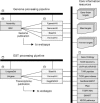Databases and information integration for the Medicago truncatula genome and transcriptome
- PMID: 15888676
- PMCID: PMC1104158
- DOI: 10.1104/pp.104.059204
Databases and information integration for the Medicago truncatula genome and transcriptome
Abstract
An international consortium is sequencing the euchromatic genespace of Medicago truncatula. Extensive bioinformatic and database resources support the marker-anchored bacterial artificial chromosome (BAC) sequencing strategy. Existing physical and genetic maps and deep BAC-end sequencing help to guide the sequencing effort, while EST databases provide essential resources for genome annotation as well as transcriptome characterization and microarray design. Finished BAC sequences are joined into overlapping sequence assemblies and undergo an automated annotation process that integrates ab initio predictions with EST, protein, and other recognizable features. Because of the sequencing project's international and collaborative nature, data production, storage, and visualization tools are broadly distributed. This paper describes databases and Web resources for the project, which provide support for physical and genetic maps, genome sequence assembly, gene prediction, and integration of EST data. A central project Web site at medicago.org/genome provides access to genome viewers and other resources project-wide, including an Ensembl implementation at medicago.org, physical map and marker resources at mtgenome.ucdavis.edu, and genome viewers at the University of Oklahoma (www.genome.ou.edu), the Institute for Genomic Research (www.tigr.org), and Munich Information for Protein Sequences Center (mips.gsf.de).
Figures



Comment in
-
Biological databases for plant research.Plant Physiol. 2005 May;138(1):1-3. doi: 10.1104/pp.104.900158. Plant Physiol. 2005. PMID: 15888672 Free PMC article. No abstract available.
References
-
- Arumuganathan K, Earle ED (1991) Nuclear DNA content of some important plant species. Plant Mol Biol Rep 9: 208–218
Publication types
MeSH terms
LinkOut - more resources
Full Text Sources
Research Materials

